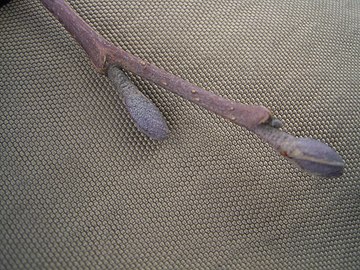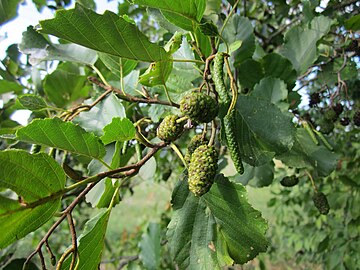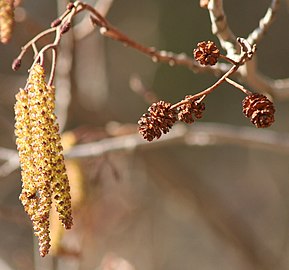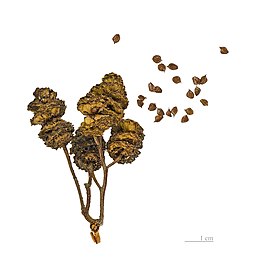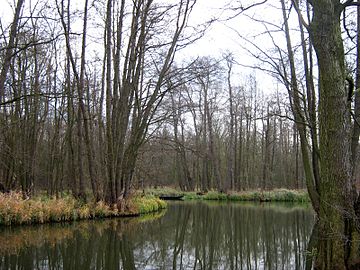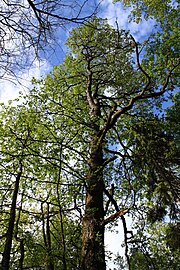Alnus glutinosa
| Alnus glutinosa | |
|---|---|
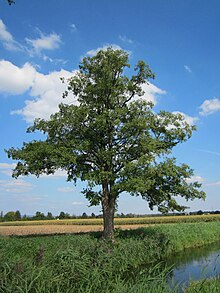
| |
| Scientific classification | |
| Kingdom: | Plantae |
| Clade: | Tracheophytes |
| Clade: | Angiosperms |
| Clade: | Eudicots |
| Clade: | Rosids |
| Order: | Fagales |
| Family: | Betulaceae |
| Genus: | Alnus |
| Subgenus: | Alnus subg. Alnus
|
| Species: | A. glutinosa
|
| Binomial name | |
| Alnus glutinosa | |

| |
| Distribution map | |
| Synonyms[3] | |
| |
Alnus glutinosa, the common alder, black alder, European alder, European black alder, or just alder, is a
The common alder provides food and shelter for wildlife, with a number of insects, lichens and fungi being completely dependent on the tree. It is a
Description
A. glutinosa is a tree that thrives in moist soils, and grows under favourable circumstances to a height of 20 to 30 metres (66 to 98 feet) and exceptionally up to 37 m (121 ft).
The
The species is
Unlike some other species of tree, common alders do not produce shade leaves. The respiration rate of shaded foliage is the same as well-lit leaves but the rate of assimilation is lower. This means that as a tree in woodland grows taller, the lower branches die and soon decay, leaving a small crown and unbranched trunk.[8]
-
Bark
-
Buds
-
Foliage
-
Male inflorescence (left) and mature cone-like flowers (right)
-
Infrutescence and achenes
Taxonomy
A. glutinosa was first described by Carl Linnaeus in 1753, as one of two varieties of alder (the other being Alnus incana), which he regarded as a single species Betula alnus.[9] In 1785, Jean-Baptiste Lamarck treated it as a full species under the name Betula glutinosa.[10] Its present scientific name is due to Joseph Gaertner, who in 1791 accepted the separation of alders from birches, and transferred the species to Alnus.[2] The epithet glutinosa means "sticky", referring particularly to the young shoots.[11]
Within the genus Alnus, the common alder is placed in subgenus Alnus as part of a closely related group of species including the grey alder, A. incana,
Distribution and habitat
The common alder is native to almost the whole of continental Europe (except for both the extreme north and south) as well as the
European alder does not usually grow in areas where the average daily temperature is above freezing for longer than six months; its range is mainly restricted in Scandinavia, but it also habitats other regions.[17]
It requires 500 millimeters of rain to fall annually in the southeastern boundary distribution of Eurasia. Although European alder can withstand winter temperatures as low as -54°C, winter damage causes 80% of young European alder plantings in North Carolina to die back.[17]
Given the overwinter minimum of -18°C, early low temperatures in November and December may have caused more damage than the intense cold.[17]
Ecology
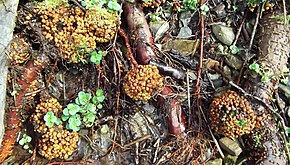


The common alder is most noted for its
The common alder is susceptible to
The common alder is important to wildlife all year round and the seeds are a useful winter food for birds. Deer, sheep, hares and rabbits feed on the tree and it provides shelter for livestock in winter.
As an introduced species, the common alder can affect the ecology of its new locality. It is a fast-growing tree and can quickly form dense woods where little light reaches the ground, and this may inhibit the growth of native plants. The presence of the nitrogen-fixing bacteria and the annual accumulation of leaf litter from the trees also alters the nutrient status of the soil. It also increases the availability of phosphorus in the ground, and the tree's dense network of roots can cause increased sedimentation in pools and waterways. It spreads easily by wind-borne seed, may be dispersed to a certain extent by birds and the woody fruits can float away from the parent tree. When the tree is felled, regrowth occurs from the stump, and logs and fallen branches can take root.[16] In the Midwestern United States, Alnus glutinosa is a highly invasive terrestrial plant and is prohibited in Indiana.[23] A. glutinosa is classed as an environmental weed in New Zealand.[24]
Toxicity
Pollen from the common alder, along with that from birch and hazel, is one of the many sources of tree pollen allergy. As the pollen is often present in the atmosphere at the same time as that of birch, hazel, hornbeam and oak, and they have similar physicochemical properties, it is difficult to separate out their individual effects. In central Europe, these tree pollens are the second most common cause of allergic conditions after grass pollen.[25]
Uses
The common alder is used as a pioneer species and to stabilise river banks, to assist in flood control, to purify water in waterlogged soils and to moderate the temperature and nutrient status of water bodies. It can be grown by itself or in mixed species plantations, and the nitrogen-rich leaves falling to the ground enrich the soil and increase the production of such trees as
On marshy ground it is important as coppice-wood, being cut near the base to encourage the production of straight poles. It is capable of enduring clipping as well as marine climatic conditions and may be cultivated as a fast-growing windbreak. In woodland natural regeneration is not possible as the seeds need sufficient nutrients, water and light to germinate. Such conditions are rarely found at the forest floor and as the forest matures, the alder trees in it die out.[26][27] The species is cultivated as a specimen tree in parks and gardens, and the cultivar 'Imperialis' has gained the Royal Horticultural Society's Award of Garden Merit.[28]
Timber
The wood is soft, white when first cut, turning to pale red; the knots are attractively mottled. The timber is not used where strength is required in the construction industry, but is used for paper-making, the manufacture of
European (common) Alder is a tonewood commonly used in the manufacture of electric guitars.[30] It exhibits a balanced, even tone with a good mid-midrange projection making it suitable for a wide variety of musical applications. It's relatively lightweight, easy to work and sand,[31] accepts glue, stain, paint and finish very well and is inexpensive. All this has made it a favourite of large factories mass producing instruments. Fender has been continuously and uninterruptedly using Alder to make electric guitars since 1956.[30]
Tanning and dyeing
The bark of the common alder has long been used in tanning and dyeing. The bark and twigs contain 16 to 20%
Medicine
The bark of common alder has traditionally been used as an
In a research study, extracts from the seeds of the common alder have been found to be active against all the eight pathogenic bacteria against which they were tested, which included Escherichia coli and methicillin-resistant Staphylococcus aureus (MRSA). The only extract to have significant antioxidant activity was that extracted in methanol. All extracts were of low toxicity to brine shrimps. These results suggest that the seeds could be further investigated for use in the development of possible anti-MRSA drugs.[35]
Other uses
It is also the traditional wood that is burnt to produce
The leaves of this tree are sticky and if they are spread on the floor of a room, their adhesive surface is said to trap fleas.[32]
Chemical constituents of Alnus glutinosa include hirsutanonol, oregonin, genkwanin,[36] rhododendrin {3-(4-hydroxyphenyl)-l-methylpropyl-β-D-glucopyranoside} and (penta-2,3-dienedioic acid).[34]
References
- . Retrieved 15 July 2023.
- ^ a b "Alnus glutinosa". The International Plant Names Index. Retrieved 2014-08-31.
- ^ "Alnus glutinosa". World Checklist of Selected Plant Families. Royal Botanic Gardens, Kew. Retrieved 2014-08-31.
- ^ "Spitzenbäume". Land Brandenburg. Archived from the original on 2016-03-03. Retrieved 2009-01-19.
- ^ ISBN 978-0-416-61780-1.
- ^ a b "Trees for Life Species Profile: Alnus glutinosa". Archived from the original on 2014-03-01. Retrieved 2008-10-13.
- ^ a b Flora of NW Europe: Alnus glutinosa
- ^ .
- ^ "Betula alnus var. glutinosa". The International Plant Names Index. Retrieved 2014-08-31.
- ^ "Betula glutinosa". The International Plant Names Index. Retrieved 2014-08-31.
- ISBN 978-0-600-58187-1.
- S2CID 85579093.
- ISBN 978-0-521-70772-5.
- doi:10.12705/663.4.
- ^ "Alnus glutinosa". Flora Europaea. Royal Botanic Garden Edinburgh. Retrieved 2014-08-09.
- ^ a b c d e "Alnus glutinosa (tree)". Global Invasive Species Database. IUCN SSC Invasive Species Specialist Group. 2010-08-27. Archived from the original on 2014-08-11. Retrieved 2014-08-04.
- ^ a b c d Birch, B. (1990). Alnus glutinosa (L.) Gaertn. European Alder. Silvics of North America: Hardwoods, (654), 105.
- S2CID 84165205.
- ^ "Phytophthora Disease of Alder" (PDF). Archived from the original (PDF) on 2015-09-24. Retrieved 2008-10-13.
- ^ Ellis, Hewett A. (2001). Cecidology. Vol.16, No.1. p. 24.
- ^ a b c d Featherstone, Alan Watson (2012-11-26). "Common or black alder". Trees for life. Archived from the original on 2014-03-01. Retrieved 2014-08-07.
- ISBN 978-0-00-219080-0.
- ^ Indiana Invasive Species Council (17 April 2020). "Official IISC Invasive Plant List". West Lafayette, Ind.: Purdue University. Retrieved 2020-12-25.
- ISBN 978-0-478-14412-3.
- ^ "Erle: Schwarzerle, Alnus glutinosa". Alles zur Allergologie (in German). Retrieved 2014-08-05.
- ^ a b "Alnus glutinosa - (L.)Gaertn". Plants For A Future. 2012. Retrieved 2014-08-05.
- ^ Kajba, D. & Gračan, J. (2003). "Alnus glutinosa" (PDF). EUFORGEN Technical Guidelines for Genetic Conservation and Use for Black Alder: 4 p. Archived from the original (PDF) on 2017-01-18.
- ^ "Alnus glutinosa Imperialis". Royal Horticultural Society. Retrieved 2014-08-06.
- ^ Paterson, J. M. "The Alder Tree". A Tree in Your Pocket. Archived from the original on 2012-11-13. Retrieved 2014-08-03.
- ^ a b Ash vs. Alder: What's the Difference?
- ^ European Alder (Alnus glutinosa)
- ^ a b c d Grieve, M. "Alder, Common". Botanical.com: A Modern Herbal. Retrieved 2014-08-05.
- ISBN 978-0-486-15609-5.
- ^ PMID 22279375.
- ^ Middleton, P.; Stewart, F.; Al-Qahtani, S.; Egan, P.; O'Rourke, C.; Abdulrahman, A.; Byres, M.; Middleton, M.; Kumarasamy, Y.; Shoeb, M.; Nahar, L.; Delazar, A.; Sarker, S. D. (2005). "Antioxidant, Antibacterial Activities and General Toxicity of Alnus glutinosa, Fraxinus excelsior and Papaver rhoeas". Iranian Journal of Pharmaceutical Research. 4 (2): 101–103.
- ISSN 0305-1978.
External links
- Alnus glutinosa - distribution map, genetic conservation units and related resources. European Forest Genetic Resources Programme (EUFORGEN)
 Data related to Alnus glutinosa at Wikispecies
Data related to Alnus glutinosa at Wikispecies- "Alnus glutinosa". Plants for a Future.
- Alnus glutinosa in the CalPhotos photo database, University of California, Berkeley



